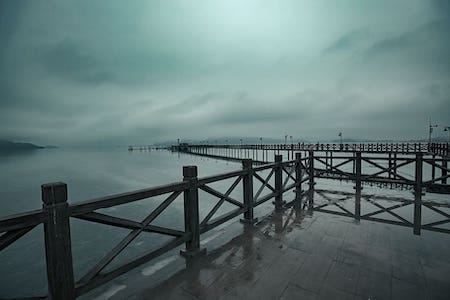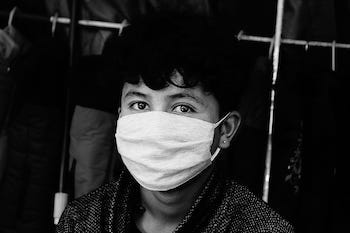
Image by Wolfsoul, North Bergen, NJ
This week: This issue is focused on reflection.
Falling asleep during a pandemic

At the start of the pandemic, I reread some of the Buddhist teachings about facing and embracing death, but honestly, my life-long practice has been much more around the denial of death and aging than leaning into acceptance of either. Lying in bed at the close of the day, with fears exploding and my body wishing to sleep, what calms me is a blend of breathing and dreaming.
For a while, at night during my sourdough fling, I thought about kneading a loaf of bread, turning the dough over and over. I’ve thought many times about the cool, grey water on a lake in Michigan where I watched the small, rhythmic waves slap the dock as I sat in a rocker on the porch, or went out in a boat and rowed. I’ve also thought about a wooded trail, walking through trees as sun filters down through brown branches and green leaves. Also walking on the beach, waves crashing as sun sparkles and cooling breezes blow. Sometimes, if none of these thoughts work, I imagine my childhood home as I walk through the rooms and look in the closets, or the now-defunct enormous ice rink I skated around, over and over, on the top of an office building in midtown New York.
If I am lucky, I drowse off into a half-dream, and then asleep. Usually, I am then out for the next five hours. At that point, I get up in the middle of the night and pee. After that, I go back to bed and either fall asleep instantly or I don’t,
If I am awake in bed, I try to not revert to thoughts like “What if I have a sore throat and I wake up with the start of COVID-19 and it’s too late to do anything about it, anyway?” and “What if I never see my son again and get sick and die and I can’t see him before that happens?” and ‘What if I get sick and have to be intubated?”
IIn the dark, I have to push all that away. I concentrate on how cool the sheets feel, how cozy the blankets are, how deeply my partner is breathing, and how much I want to close my eyes and sleep because it is still night and not yet morning.
And then, at a certain point, my eyes open once more, and even with the blackout shades drawn, I know it is the day.
And I am alive, and I am not sick, and there is #Gratitude.

Quick takes: Pandemic voices of power and truth
As someone said on Twitter, “We moved from depression to bread to revolution.”
PolicyLink, COVID-10, and Race: Commentary, by Angela Glover Blackwell I greatly admire PolicyLink founder Angela Glover Blackwell, whose new commentary is an important read. She writes:
“There’s a growing consensus that something is fundamentally wrong in America, tied to racism and exclusion. A recent poll found that 76 percent of Americans consider racism and discrimination a “big problem,” up 26 points from 2015. This is a remarkable change in just a few years. “
Blackwell also says” This feels like a seismic shift and the beginning of America’s next story,” and I hope she is right.
The Atlantic, There’s No Going Back to ‘Normal’ by Ekemini Uwan Must read: “America has the highest number of coronavirus cases in the world, and the virus is likely to spread further due to the reopening of state and local economies, as well as the Black Lives Matter protests (though public-health officials have endorsed them). “
The Counter, I won’t remember how unforgiving Covid-19 was to people like me. Instead, I’ll remember Sunday dinner, Lesley Lamar Parker. This lovely essay is by a writer who passed from COIVD-19.
“This is how I’ll choose to remember Covid-19: the virus forced distance between us, but it also made us closer.”
Autostraddle, Black rage as catharsis by danijanae. A searing essay: “I want Black people to be able to feel the entirety of their pain, to let it manifest in ways that don’t harm us instead. Without feeling the extent of our rage, we can’t truly imagine the scope of our joy.”
“To be Black in America is to be perpetually breathless, is to have hands around your throat, is to be mad as hell.”
Food and Wine: How I got radicalized around food, by Devita Davison
“We don't use the words “food desert.” What we use is a more appropriate term, “food apartheid,” meaning our neighborhoods and communities in the city of Detroit and communities that have been occupied with Black and brown bodies all over this country, whether it's Detroit, Harlem, the Bronx, Oakland, parts of Baltimore, DC—we live under food apartheid. A desert is a natural phenomenon, but having lack of access to fresh, healthy, affordable food is not natural, nor is it accidental.”

MAKING: What’s an object or tool you’re now using all the time? For guest poster C.J. Hirschfield, it’s her mandoline kitchen slicer:
My mandoline slicer has become my go-to gadget now that I’m cooking so many damn meals. It’s small, easy to clean, does not require electricity, and it quickly and elegantly slices vegetables and fruits into thin, uniform slices. Now that we’re particularly appreciating foods that do well when stored, the mandoline is perfect for slicing cabbage for coleslaw, potatoes for baked chips or gratin, apples for pies, cucumbers for salads, onions and peppers to top pizzas, citrus to flavor water. It slices to an exact thickness and requires significantly less skill and effort than cutting with a knife. Oh, and you can buy a good one for under $40.
It doesn’t bother me at all that my new favorite quarantine kitchen device was invented by the same man who invented the guillotine. I mean, the ancient Chinese invented both gunpowder and fireworks; ingenuity and creativity can be used for good or evil. And, “playing” my mandoline feels like magic.
But its guillotine roots should not be ignored. A 2016 New York Times article cautions that cooking tools add convenience—“and danger.” It quotes the then-executive producer of Bravo’s “Top Chef” program as saying “Got to watch out for the mandoline. It’s got to be one of the most dangerous home tools. It will cut your hand in a heartbeat.”
Okay, so that’s why mine comes with a safety gizmo that separates fingers from the blade, and I’ve only been nicked once. But I was wounded in the most worthy cause of coleslaw that, well, killed.
Want to know more? Kitchen Project published a great article on the history, operation, and usage tips of the mandoline.
Want to get one? Here’s a rundown of the best mandolines of 2020.
What tools are you now obsessed with? Share in comments, please.
You Made It This Far, So Here is One More Thing

Something I saw, by kimberley rose drew. When I started CYB, I checked out dozens of other Substack newsletters and signed up to about 40 of them. One that is getting my attention over and over is the magical and exciting Something I saw, a daily sharing of a piece of artwork, curated by kimberley rose drew. I just signed up to be a full subscriber, and I am excited.

Senga Nengudi, Ceremony for Freeway Fets, March 1978
CONTRIBUTING WRITERS--Maybe you? If you’d be interested in contributing occasionally (and there is a loose format and NEW guidelines), drop me a line with some ideas and possible timing.
Thanks for reading #5. A whole month of doing this, and cases are still surging.
#6 hits next Sunday. Subscribe if you like it. And tell your friends.


